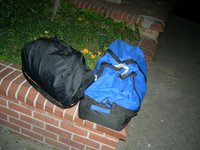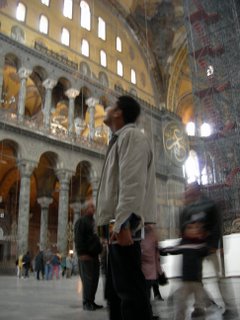Ataturk Havalimaani is the first time we have landed ‘abroad’ together- we even flew to Singapore separately. It is late evening, past 5pm local time, as we stride through the very regular looking walkways, the occasional smile to fellow passengers recognised from the frantic running at Doha. We’re in the pretty short lines for immigration; I step up first and say “
Merhaba…?...yes?”.
That’s hello in Turkish, and the official smiles and gives me the correct pronunciation. That’s the first of many
‘merhabas’ we shall hear. He pulls D’s leg a bit about retaining her passport, and then sets us off with a cheery “
gule gule” (gewleh gewleh).
The Lonely Planet says Istanbul airport charges about a Euro for the use of trolleys, so we more or less abandoned the idea of one. As I bought a bottle of Smirnoff for the trip, though (another cost saving measure), Devika retrieved a trolley from somewhere- and no one was paying anything. Ahead of me in the line were two 30-ish Turkish men, with their allotted quota of two litres of spirit. We’d bumped into them a few times since Doha, and by the time I told them we could take more booze for them on our quota, they had passed ahead.
One of the best resources for turkey travel, particularly the capital, is the
TTP. So we’ve got some extracts to add on to the trusty LP. Very useful of these is the step by step guides of getting from the airport to the main tourist accommodation area- Sultanahmet- which we fish out and begin to follow. At the exit we are hit by the cold. Its chilly, but there will be time to feel that later! We notice the same young chaps, one of whose parents and family have come to receive him with hugs and kisses terribly reminiscent of IGI Airport. The other, smiley fellow smiles at us yet again asking where we’re headed, and if by taxi. When we reveal our great plan of guided Metro-tram travel, he says we could go together; as I hurriedly stuff the Smirnoff into one of the bags and lock it.
Our new found companion has never used the Metro either (isn’t that a little odd?) As we approach the ticket counter it dawns on us just how spaced / unused to this we are- we have not changed our money! Asking him to carry on, we turn to head back to the main airport- but wait, he will have none of it. With the first of many “its not important”s from him, he buys our tokens before we can say Mustafa Kemal Ataturk. Shaking our heads, we follow him- bewildered and embarrassed, if smiley.
Istanbul seems to function on a combination many modes of transport- the metro, tramway, buses, ferries, suburban train and
taksis. The partly underground metro- entirely so for the 6 stops we travel on it- takes us to Zeytinburnu, the starting point for the surface tramway which will take us to where we need to go. There are no money exchangers around, and our tram tickets too are bought by Ufuk, a ship captain. We feel even more foolish, very grateful and quite taken aback by it all.
It is evening now- the sun is setting so everything we see is in quickly- fading light. Like the little glimpses from the airplane suggested, the city seems to be quite low lying. We see nothing more than a few storeys high, but whether that is normal or only in the areas we are passing through remains to be seen. Neither the tram nor the Metro is air-conditioned (which is a big change from Singapore)- though of course the weather means we don’t need it either. The roads are like you’d expect any big city’s to be- fairly crowded, well lit buses, possibly fewer cars than I’d have thought. Ufuk must go to meet his girlfriend- whom he charmingly refers to as ‘my darling’, a couple of stops after ours, but gives us his number in case we need help in Istanbul, particularly with transalations. We bid him adieu after thanking him profusely and happily. Email ids are exchanged and the PA system informs us that we have reached Sultanahmet.
The cold comes in a chilly breeze and we dump our bags on the side and look up, but the first sight that greets us is brightness in the night.

We don’t quite know it, but are suitably impressed- the hotel is priority, though. We eventually did
not do what we said book through the net, though without any payment.
Hotel Antique offered us a room for 30Euros a night with a free one-way airport transfer thrown in- and we figured what the heck- saves us the bother. We found this through the Rough Guide on the net, and few mentions in the Thorn Tree forums- but it doesn’t feature in the Lonely Planet. We have the address though, and the map of Sultanahmet in the LP orients me with where the street is, or at least the general direction of it. Or so I thought. Five minutes walk west of the tram station and we are accosted by a street café manager.
“My friend, can I help you…”
He proceeds to give us detailed directions to Hotel Antique which seem a little at odds with my understanding of the map. Given his complete lack of any ulterior motive (he did not try to sell us carpets or get us to eat at his place), we followed his instructions till we reached the previous tram stop. Make that “the
previous tram stop”! Surely this could not be right. A couple of more people were asked for directions- a little difficult, the communication given they had not even a smattering of English at their disposal.

The fourth person was a shop owner standing disinterestedly. He took the book from D’s hands (where the address was scribbled), promptly turned back into his shop, picked up the phone and called the hotel to figure out where they were. Lo and behold we have the correct direction! Back exactly to where we had begun, (encountering the café chap again who was baffled that his directions were wrong and very reluctantly let us on our way), we pass what we now know are the turrets of the Blue Mosque lit up for the festive season; and find ourselves, all of a sudden, in the midst of a bright, bustling and noisy street market. More like a carnival, actually. We manoeuvred our way past innumerable food stalls, almost as many kebab skewers and countless people eating something or the other and eventually, about 40-45 minutes after getting off the tram and lugging around not-real backpacks
like backpacks, we arrive at Kucuk Ayasofya Cadessi, and the tiny, tiny 3-storey thing professing, against the odds, to be a Hotel.

We did not come expecting a mansion and do not get one. But the room looks adequate, the loo is clean and though they both are as tiny as the facade suggests they’d be, it doesn’t really matter right now; for finally, at about 8.30pm on October 14, our stay in Istanbul can officially begin.
in: travel / turkey / turkey travel / istanbul
 LP recommends a place east of the area, towards the train line and Marmara Sea, frequented by locals (always the best kind); but we still haven’t changed money (!) so we are back to main street where the tram is. We are seeing it by day, and everything g looks different. This is Divan Yolu, the main street in Sultanahmet. On it run trams, buses, cars and lots of people either side. Divan Yolu is the old road to Rome, with the Milion- a marble milestone from which all distaces in Byzantium were measured at one end- it is soon to become a favourite stretch.
LP recommends a place east of the area, towards the train line and Marmara Sea, frequented by locals (always the best kind); but we still haven’t changed money (!) so we are back to main street where the tram is. We are seeing it by day, and everything g looks different. This is Divan Yolu, the main street in Sultanahmet. On it run trams, buses, cars and lots of people either side. Divan Yolu is the old road to Rome, with the Milion- a marble milestone from which all distaces in Byzantium were measured at one end- it is soon to become a favourite stretch. The rice is tasty, though there is nothing in it- a little salt, what I suspect is olive oil and fattish grains of rice, but not sticky. With it I have spinach, which is mild but rather tasty; D has a meat thing and patlican dish with her rice. The former is ok, the latter she likes- even I taste it and its quite nice. With it we have a yogurt thing (basically, raita-curd and cucumber, watery and more sour than either of us would like). We exceed our meal budget (a max of 10Euros between us), but I am entering ‘doesn’t matter, D eat as much as you want’ mode; she is less reckless right now. Come to think of it now, it sounds like we would exceed our budget with that lineup, bang in the middle of tourist central- but its ok. D resolves to be more aware while ordering- the budget is her look-out, sort of. Hmm. Best of luck, D.
The rice is tasty, though there is nothing in it- a little salt, what I suspect is olive oil and fattish grains of rice, but not sticky. With it I have spinach, which is mild but rather tasty; D has a meat thing and patlican dish with her rice. The former is ok, the latter she likes- even I taste it and its quite nice. With it we have a yogurt thing (basically, raita-curd and cucumber, watery and more sour than either of us would like). We exceed our meal budget (a max of 10Euros between us), but I am entering ‘doesn’t matter, D eat as much as you want’ mode; she is less reckless right now. Come to think of it now, it sounds like we would exceed our budget with that lineup, bang in the middle of tourist central- but its ok. D resolves to be more aware while ordering- the budget is her look-out, sort of. Hmm. Best of luck, D.








































